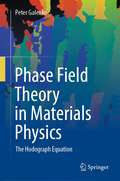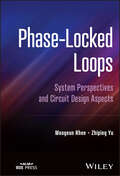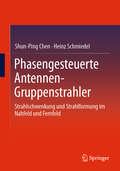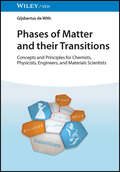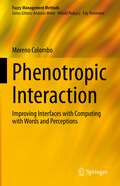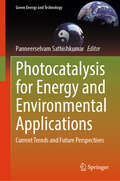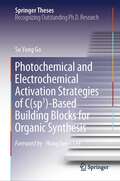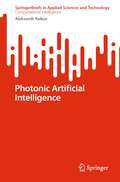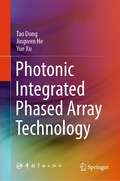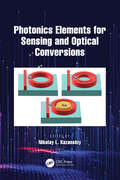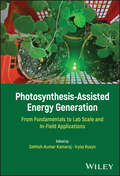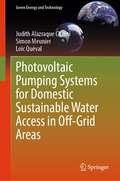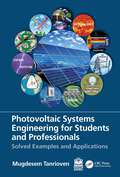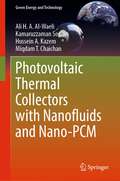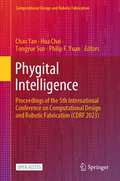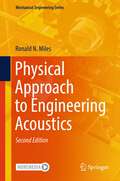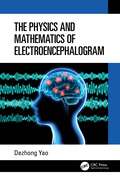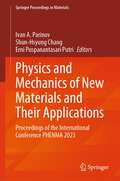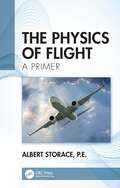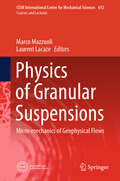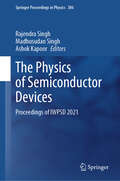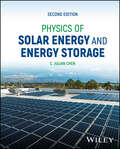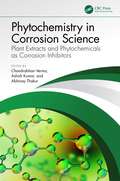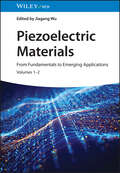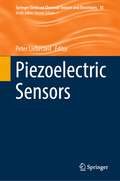- Table View
- List View
Phase Field Theory in Materials Physics: The Hodograph Equation
by Peter GalenkoThis book deals with the use of the hodograph equation in phase transformations in condensed matter, especially, for crystallization and solidification processes. The main focus of the book is the interpretation of the phase-field equations for isotropic and anisotropic interfaces based on the advanced Gibbs–Thomson and Herring conditions, respectively. Beginning with the basic ideas behind the extended irreversible thermodynamics, the kinetic phase-field model for slow and arbitrarily fast phase transformations is derived where the unified hodograph equation follows from:• the sharp interface limit of the diffuse interface or• the traveling wave solution of the propagating phase field.Under the example of solute trapping and disorder trapping effects, comparing theoretical results with molecular dynamics simulations, and with the analysis of experimental data, the concrete workability of the developed hodograph equation is demonstrated for widest range of driving force in phase transformations.
Phase-Locked Loops: System Perspectives and Circuit Design Aspects
by Woogeun Rhee Zhiping YuPhase-Locked Loops Discover the essential materials for phase-locked loop circuit design, from fundamentals to practical design aspects A phase-locked loop (PLL) is a type of circuit with a range of important applications in telecommunications and computing. It generates an output signal with a controlled relationship to an input signal, such as an oscillator which matches the phases of input and output signals. This is a critical function in coherent communication systems, with the result that the theory and design of these circuits are essential to electronic communications of all kinds. Phase-Locked Loops: System Perspectives and Circuit Design Aspects provides a concise, accessible introduction to PLL design. It introduces readers to the role of PLLs in modern communication systems, the fundamental techniques of phase-lock circuitry, and the possible applications of PLLs in a wide variety of electronic communications contexts. The first book of its kind to incorporate modern architectures and to balance theoretical fundamentals with detailed design insights, this promises to be a must-own text for students and industry professionals. The book also features: Coverage of PLL basics with insightful analysis and examples tailored for circuit designers Applications of PLLs for both wireless and wireline systems Practical circuit design aspects for modern frequency generation, frequency modulation, and clock recovery systems Phase-Locked Loops is essential for graduate students and advanced undergraduates in integrated circuit design, as well researchers and engineers in electrical and computing subjects.
Phasengesteuerte Antennen- Gruppenstrahler: Strahlschwenkung und Strahlformung im Nahfeld und Fernfeld
by Shun-Ping Chen Heinz SchmiedelIn diesem Buch werden die Grundlagen der Strahlformung von Antennen erläutert. Die Prinzipien der Strahlfokussierung und Strahlschwenkung im Nah- und Fernfeld werden mit 2D- und 3D-Simulationen visualisiert und mit Messergebnissen verglichen. Neben linearen und planaren Antennen-Gruppenstrahlern werden auch konforme Gruppenstrahler, also konkave und konvexe Antennen-Gruppenstrahler, die für bestimmte Anwendungen geeignet sind, untersucht und vorgestellt. Auch verwandte Anwendungen der Strahlformung, wie Open-Loop- und Closed-Loop-Antennen-Gruppenstrahler oder Massive MIMO, eine der bahnbrechenden Technologien für 5G und zukünftiges 6G, die eine extrem große Anzahl von Antennenelementen für die Multi-Nutzer-Funkversorgung erfordert, werden behandelt. Weiterhin wird auch Strahlformung der sogenannten ausgedünnten Antennen-Gruppenstrahler mit großen Abständen zwischen den Antennenelementen diskutiert. Dieses Buch richtet sich sowohl an Forschungs- und Entwicklungsingenieure als auch an Studierende in den Bereichen Hochfrequenztechnik und Telekommunikation.
Phases of Matter and their Transitions: Concepts and Principles for Chemists, Physicists, Engineers, and Materials Scientists
by Gijsbertus de WithPhases of Matter and their Transitions An all-in-one, comprehensive take on matter and its phase properties In Phases of Matter and their Transitions, accomplished materials scientist Dr. Gijsbertus de With delivers an accessible textbook for advanced students in the molecular sciences. It offers a balanced and self-contained treatment of the thermodynamic and structural aspects of phases and the transitions between them, covering solids, liquids, gases, and their interfaces. The book lays the groundwork to describe particles and their interactions from the perspective of classical and quantum mechanics and compares phenomenological and statistical thermodynamics. It also examines materials with special properties, like glasses, liquid crystals, and ferroelectrics. The author has included an extensive appendix with a guide to the mathematics and theoretical models employed in this resource. Readers will also find: Thorough introductions to classical and quantum mechanics, intermolecular interactions, and continuum mechanics Comprehensive explorations of thermodynamics, gases, liquids, and solids Practical discussions of surfaces, including their general aspects for solids and liquids Fulsome treatments of discontinuous and continuous transitions, including discussions of irreversibility and the return to equilibrium Perfect for advanced students in chemistry and physics, Phases of Matter and their Transitions will also earn a place in the libraries of students of materials science.
Phenotropic Interaction: Improving Interfaces with Computing with Words and Perceptions (Fuzzy Management Methods)
by Moreno ColomboSuccessful interaction between humans and artificial systems allows for combining the advantages of all actors in solving problems. However, interaction is often demanding for people, as it builds on artificial concepts, such as strict protocols.This book presents the new paradigm of 'phenotropic' interaction, which aims to improve the naturalness of the interaction thanks to bio-inspired approaches. These include methods for understanding and reasoning with human perceptions expressed as natural language, fundamental to support the artificial system to better understand people's real desires and needs. Methods for improving the theories of computing with words and perceptions are developed in this book and applied to concrete use cases in prototypes enhancing the exchange of information with virtual assistants and smart city ecosystems. The presented use cases serve not only as examples of the application of the phenotropic interaction principles but also to verify their effective impact on communication.
Photocatalysis for Energy and Environmental Applications: Current Trends and Future Perspectives (Green Energy and Technology)
by Panneerselvam SathishkumarThis book presents the existing photocatalytic reactor design and the future developments and the progress needed for both solar light-driven hydrogen generation and environmental purification. The chapters discuss the renewable and commercial aspects of translucent polymer-linked heterojunction nanocomposites as visible light-responsive photocatalysts. Relevant to these areas, the field of growing interest in black-TiO2, perovskites, MXenes and their numerous applications are presented. The framework, structural features and the need of mesocrystals for solar light-driven photocatalysis are also included. The book also discusses the additional features of green chemistry-based synthesis of nanomaterials in order to reduce any secondary pollution that may be released in the environment due to unsafe disposal of solvents. In addition, the importance of bismuth-based nanophotocatalysts towards energy and environmental applications and their future development as alternative photocatalysts for the prevailing nanomaterials are presented. The book also touches upon the idea to generate green fuel hydrogen through photocatalytic and photoelectrochemical techniques. Overall the book highlights contemporary developments in the last decade, the future perspectives of photocatalysis and its application towards energy and environment.
Photochemical and Electrochemical Activation Strategies of C (Springer Theses)
by Su Yong GoThis book addresses novel C(sp3)-C(sp2) and C(sp3)-heteroatom bond-forming reactions. Two strategies are given in the book using photoredox or electrochemical methods. The first strategy describes that the hydroalkylation of alkynes via photoredox-mediated Ni/Ir dual catalysis produces trisubstituted alkenes as versatile synthetic building blocks for the synthesis of pharmaceutical agents and natural products. High regioselectivity and E/Z-selectivity were achieved by introducing silyl groups that can provide steric and electronic effects to these selectivities with extensive opportunities for post-functionalization.The second strategy enables the development of C(sp3)-heteroatom bond-forming reactions through the electrochemical activation of C(sp3)-B bonds. The bonding of heteroatoms to carbon atoms has been an enduring subject of investigation for organic chemists. The function of most molecules is mainly determined by heteroatoms attached to the carbon atom, althoughthe backbone structure of organic compounds comprises carbon fragments.
Photonic Artificial Intelligence (SpringerBriefs in Applied Sciences and Technology)
by Aleksandr RaikovThis book addresses an attempt to create Photonic Artificial Intelligence (PAI) system based on optical technologies, which process signals continuously. PAI could help to overcome digital computer limits and almost zero out the machine learning time and AI inference. It helps to consider feelings, the chaos of thoughts, cognitive activity, and the transcendental states of the human mind in AI systems. The book also discusses new problems such as synthesizing new photonic materials, creating optical control systems, and connecting PAI systems with outside digital computers and holographic memory. The book is aimed at a wide range of readers, including postgraduates and researchers, interested in advanced AI by creating its new paradigm, which can help to overcome traps of traditional AI development.
Photonic Integrated Phased Array Technology
by Tao Dong Jingwen He Yue XuThis book primarily focuses on the authors’ research and practical achievements in the field of photonic integrated phased arrays in recent years. Firstly, a comprehensive introduction on the concept, operation principles, and research progress of photonic integrated phased arrays is introduced. Then, detailed explanations of the optical antenna and array design in photonic integrated phased arrays are given. Combined with design cases of silicon-based optical phased arrays with different scales, the design methods for achieving low sidelobes are deeply researched, and the test principle and design of photonic integrated phased arrays are elaborated. Finally, the design, implementation, and test of photonic integrated phased arrays are illustrated through a detailed case study on the development of a silicon-based optical phased array chip and verify its short-distance space optical communication based on the chip.This book is dedicated to integrating the theory, design, processing, and test cases of photonic integrated phased arrays, and it provides a valuable reference for researchers and designers in the field of optical phased array technology.
Photonics Elements for Sensing and Optical Conversions
by Nikolay L. KazanskiyThis book covers a number of a rapidly growing areas of knowledge that may be termed as diffractive nanophotonics. It also discusses in detail photonic components that may find uses in sensorics and optical transformations. Photonics Elements for Sensing and Optical Conversions, covers a number of rapidly growing areas of knowledge that may be termed as diffractive nanophotonics. The book examines the advances in computational electrodynamics and nanoelectronics that have made it possible to design and manufacture novel types of photonic components and devices boasting unique properties unattainable in the realm of classical optics. The authors discuss plasmonic sensors, and new types of wavefront sensors and nanolasers that are widely used in telecommunications, quantum informatics and optical transformations. The book also deals with the recent advances in the plasmonic sensors based on metal-insulator-metal waveguides for biochemical sensing applications. Additionally, nanolasers are examined in detail, with a focus on contemporary issues, the book also deals with the fundamentals and highly attractive applications of metamaterials and metasurfaces. The authors provide an insight into sensors based on Zernike optical decomposition using a multi-order diffractive optical element, and explore the performance advances that can be achieved with optical computing. The book is written for opticians, scientists and researchers who are interested in an interesting section of plasmonic sensors, new types of wavefront sensors and nanolasers, and optical transformations. The book will be bought by upper graduate and graduate level students looking to specialize in photonics and optics.
Photosynthesis-Assisted Energy Generation: From Fundamentals to Lab Scale and In-Field Applications
by Sathish-Kumar Kamaraj Iryna RusynPhotosynthesis-Assisted Energy Generation Describes the mechanisms of and potential for using microorganisms and plants as renewable power resources Bridging the knowledge gap between the fundamentals and the technological advances in biological photosynthesis-assisted energy generation, Photosynthesis-Assisted Energy Generation explores the various diverse light-harvesting biological systems for electricity generation and explains the fundamentals and applications from lab-scale to in-field. The text discusses the fundamentals of electron transfer mechanisms in photosynthetic systems, basic principles of bioelectricity generation, and materials involved in the construction of fuel cells, including not only the impact of higher plants, but also anoxygenic and oxygenic photosynthetic bacteria and microalgae on the performance of photosynthesis-assisted power generation systems. A timely resource, the text features case studies on emerging topics such as mosses in power generation on green roofs and photo-bioelectrochemical fuel cells for antibiotics and dyes removal, along with discussion of sustainability issues when scaling up bio-photo-electrochemical systems. Edited by two highly qualified and accomplished academics with significant research experience in the field, Photosynthesis-Assisted Energy Generation includes information on: Role of functional materials involved in photosynthesis-assisted power generation and non-noble electrocatalysts as air cathodes in biocells Electricity generation and intensified synthesis of nutrients by plant-based biofuel cells using duckweeds as biocatalysts Algae-based microbial fuel cells, photosynthetic bacteria-based microbial fuel cells, and bryophyte microbial fuel cell systems Progress and recent trends of application of low-energy consuming devices and IoT based on photosynthesis-assisted power generation Plant-based microbial fuel cells for bioremediation, biosensing, and plant health monitoring With full coverage of an attractive renewable energy generation system, Photosynthesis-Assisted Energy Generation is an essential resource on the subject for researchers and scientists interested in alternative renewable energetics and photosynthesis-assisted energy generation processes utilizing microorganisms, algae, plants, and other bioinspired materials.
Photovoltaic Pumping Systems for Domestic Sustainable Water Access in Off-Grid Areas (Green Energy and Technology)
by Judith Alazraque Cherni Simon Meunier Loïc QuévalThis book offers practical guidance for practitioner engineers, policymakers, and other decision-makers on how to implement solar photovoltaic water pumping systems to provide domestic clean water in off-grid regions of developing countries. By championing genuine multidisciplinary research and generating interdisciplinary results, this book develops models and approaches which indicate how it might be possible to overcome some of the limitations that technocratic approaches to renewable energy and water access pose to truly sustainable development.The book addresses technical challenges often found when promoting photovoltaic water pumping systems. It offers practical guidance to stakeholders on how to successfully select, install, and maintain photovoltaic water pumps to promote sustainable options for the poorest underserved areas/populations. A main novelty of this book is that, by using theoretical, as well as real/actual field-work data, and advanced modelling, it successfully connects energy systems engineering, environmental and geographical information and hydrology with population surveys which reveal local needs and conditions.The book is timely and important. More than 665 700 million worldwide still do not have access to improved drinking water sources; eight out of ten live in rural areas typically located either in off-grid territory, or where connection to nearby grid is too expensive or unfeasible. Unsafe water is responsible for 1.2 million deaths each year, mainly correlated with the diarrheal diseases generated from drinking water from unimproved water sources. Sustainable Development Goal 6 (clean water and sanitation) may be achieved only if water is accessible to everyone, available when needed and free from contamination.
Photovoltaic Systems Engineering for Students and Professionals: Solved Examples and Applications
by Mugdesem TanriovenPhotovoltaic Systems Engineering for Students and Professionals: Solved Examples and Applications examines photovoltaic (PV) power plants in a holistic way. PV installations of all types and sizes – from the smallest plant element to the largest system components – are approached from an electrical engineering perspective and further explained through worked examples. It presents the different forms of energy and the energy conversions between them in a clear and understandable way. This book is an essential resource for both students and practicing engineers working in the solar photovoltaic areas and critical work for all electrical engineers. Features: Includes over 100 worked examples and more than 80 end-of-chapter problems Presents systematic techniques and approaches to problem solving Includes PowerPoint presentations and a solutions manual for instructors Considers the effects of environmental conditions on the performance of PV systems Presents step-by-step design of photovoltaic systems of all sizes from scratch
Photovoltaic Thermal Collectors with Nanofluids and Nano-PCM (Green Energy and Technology)
by Ali H. Al-Waeli Kamaruzzaman Sopian Hussein A. Kazem Miqdam T. ChaichanThis book gives you theory and design of PV/T systems. Are you interested in solar energy? If you are, you must have read about solar panels, or photovoltaics (PV). If you have installed a photovoltaic system, you must have noticed it not to generate the amount of power mentioned in its datasheet. A major issue that PV suffers from is its temperature, which causes a drop in its power. Among the solutions to this issue is to use active cooling methods, such as the hybrid photovoltaic thermal (PV/T) system. These systems can produce electrical and thermal energy simultaneously and within same area. The thermal collector serves to cool down the PV surface temperature, which negatively affects the PV efficiency, to reclaim the efficiency or bring it back close to standard testing conditions value. Moreover, the thermal collector will convey this heat using a working fluid and extract it as thermal energy. On the other hand, the electrical power generated from the PV can be utilized in standalone or grid-connected configuration. Moreover, the book presents a novel PV/T collector which can utilize nanofluids and nano-Phase Change Material (PCM) to enhance its performance in tropical climate conditions. The methods used to develop the heat transfer and energy balance equations are presented as well. PV/T collector numerical simulation using MATLAB and computational fluid dynamic (CFD) was also presented. Finally, the approach of life cycle cost analysis (LCCA) is presented to evaluate PV/T with nanofluid and nano-PCM, economically.
Phygital Intelligence: Proceedings of the 5th International Conference on Computational Design and Robotic Fabrication (CDRF 2023) (Computational Design and Robotic Fabrication)
by Chao Yan Hua Chai Tongyue Sun Philip F. YuanThis open access book is a compilation of selected papers from 2023 DigitalFUTURES — The 5nd International Conference on Computational Design and Robotic Fabrication (CDRF 2023). The work focuses on novel techniques for computational design and robotic fabrication. The contents make valuable contributions to academic researchers, designers, and engineers in the industry. As well, readers will encounter new ideas about understanding intelligence in architecture.
Physical Approach to Engineering Acoustics (Mechanical Engineering Series)
by Ronald N. MilesThis updated edition adds new material on the acoustics of mufflers and ducts, including a new analysis on sound propagation in a duct having a cross sectional area that varies in the direction of the duct length. The textbook retains its class-tested fundamentals of engineering acoustics and examination of in-depth concepts within the domains that apply to reducing noise, measuring noise, and designing microphones and loudspeakers. The book particularly emphasizes the physical principles used in designing miniature microphones. These devices are used in billions of electronic products, most visibly, cell phones and hearing aids, and enable countless other applications. Distinct from earlier books on this topic that take the view of the electrical engineer analyzing mechanical systems using electric circuit analogies. This text uses Newtonian mechanics as a more appropriate paradigm for analyzing these mechanical systems and in so doing provides a more direct method of modeling. Written at a level appropriate for upper-division undergraduate and graduate courses, and enhanced with end-of-chapter problems and MatLab routines, the book is ideal as a core text for students interested in engineering acoustics in ME, EE, and physics programs, as well as a reference for engineers and technicians working in the huge global industry of miniature microphone design.
The Physics and Mathematics of Electroencephalogram
by Dezhong YaoThis book focuses on a systematic introduction to the knowledge of mathematics and physics of electroencephalogram (EEG) and discusses an in-depth application of EEG and the development of new methods and technologies for mining and analyzing EEG.The Physics and Mathematics of Electroencephalogram offers a systematic overview of the technology for brain function and disease. It covers six parts: background knowledge of EEG, EEG forward problems, high-resolution EEG imaging, EEG inverse problems, EEG reference electrode, and EEG cloud platform. The author reviews the critical technologies in brain function and disease, such as EEG sourcing, EEG imaging, and EEG reference electrode standardization technique. The book’s aim is to clarify the mechanism of EEG from the perspective of physics, mathematics, and engineering science to help multidisciplinary readers better understand and use EEG information more effectively.This book can be used as reference for researchers in the fields of neuroengineering, cognitive neuroscience, neurology, psychiatry, applied mathematics, and brain-like intelligence.
Physics and Mechanics of New Materials and Their Applications: Proceedings of the International Conference PHENMA 2023 (Springer Proceedings in Materials #41)
by Ivan A. Parinov Shun-Hsyung Chang Erni Puspanantasari PutriThis book presents 60 selected peer-reviewed contributions from the international conference Physics and Mechanics of New Materials and Their Applications, PHENMA 2023 (3-8 October, 2023, Surabaya, Indonesia), focusing on processing techniques, physics, mechanics, and applications of advanced materials. The book describes a broad spectrum of promising nanostructures, crystal structures, materials, and composites with unique properties. It presents nanotechnological design approaches, environmental-friendly processing techniques, and physicochemical as well as mechanical studies of advanced materials. The selected contributions describe recent progress in energy harvesting and piezoelectric materials optimization, electromagnetoelastic actuators for nanotechnology research, impedance spectroscopy and study of ceramic materials, catalyst synthesis and control of morphological characteristics, synthesis and study of electrocatalysts for fuel cells. The presented results are important forongoing efforts concerning the theory, modelling, and testing of advanced materials. Other results are devoted to the analysis of technogenic raw materials and different material applications in science, technique and industry.
The Physics of Flight: A Primer
by Albert StoraceThe Physics of Flight provides a comprehensive explanatory reference on the basic physics of flight with a clear presentation of the underlying mathematics. It presents a momentum-based explanation of lift making no use of Bernoulli’s theorem. Misconceptions are disproved, such as identifying centrifugal force experienced in an airplane undergoing maneuvers as a fictitious force, and not attributing weightlessness during airplane pitch over or experienced in an airplane performing a parabolic flight path to the effects of free fall. This book places particular emphasis on Newton’s second law of motion to explain the effects of forces acting on an airplane, the mechanism of lift, and the principles of propulsion. This book is intended for undergraduate aviation and aerospace students taking courses in Flight Dynamics, Introduction to Flight, and Physics of Flight.
Physics of Granular Suspensions: Micro-mechanics of Geophysical Flows (CISM International Centre for Mechanical Sciences #612)
by Marco Mazzuoli Laurent LacazeThis book provides graduate students and scientists with fundamental knowledge on the mechanics of granular suspensions as well as on the mathematical and numerical techniques that can be adopted to investigate geophysical flows. To this end, three formidably complex problems (sediment transport, flow-like landslide inception, and gravity currents) are considered. The reader will find a thorough combination of elements of fluid and solid mechanics, rheology, geotechnics, geomorphology, civil, and coastal engineering. The first part of the book introduces the problem of granular suspensions from the mathematical viewpoint, focusing on issues that characterise geophysical flows such as turbulence, the effects of inter-particle contacts, and strong velocity gradients. In the second part, different models that were successfully used to investigate the mechanics of granular suspensions in environmental flows are presented.
The Physics of Semiconductor Devices: Proceedings of IWPSD 2021 (Springer Proceedings in Physics #306)
by Rajendra Singh Madhusudan Singh Ashok KapoorThis book includes proceedings of the 21st International Workshop on Physics of Semiconductor Devices. The workshop is jointly organized by the Indian Institute of Technology, Delhi, and Solid State Physics Laboratory, Delhi, in collaboration with the Society for Semiconductor Devices and Semiconductor Society of India. This book disseminates the current knowledge of semiconductor physics and its applications across the scientific community. It is based on a biennial workshop that provides the participating research groups with a stimulating platform for interaction and collaboration with colleagues from the same scientific community. The book discusses the latest developments in III-nitrides; materials and devices, compound semiconductors, VLSI technology, optoelectronics, sensors, photovoltaics, crystal growth, epitaxy, and characterization, graphene, and other 2D materials and organic semiconductors. The research articles included in this book are contributed by various eminent scientists from all over the world. The book serves as a reference resource for researchers and practitioners in academia and industry.
Physics of Solar Energy and Energy Storage
by C. Julian ChenPHYSICS OF SOLAR ENERGY AND ENERGY STORAGE Join the fight for a renewable world with this indispensable introduction Solar energy is one of the most essential tools in the fight to create a sustainable future. A wholly renewable and cost-effective energy source capable of providing domestic, business, and industrial energy, solar energy is expected to become a $223 billion a year industry by 2026. The future of global energy production demands researchers and engineers who understand the physics of harnessing, storing, and distributing solar energy. Physics of Solar Energy and Energy Storage begins to meet this demand, with a thorough, accessible overview of the required fundamentals. Now fully updated to reflect the past decade of research amidst a growing understanding of the scale of our collective challenge, it promises to train the next generation of researchers and engineers who will join this vital effort. Readers of the second edition of Physics of Solar Energy and Energy Storage will find: A particular focus on lithium-ion rechargeable batteries Detailed discussions of photovoltaic solar systems, concentrating solar systems, passive solar heating, and more Homework problems and exercises throughout to reinforce learning Physics of Solar Energy and Energy Storage is ideal for mechanical, chemical, or electrical engineers working on solar or alternative energy projects, as well as researchers and policymakers in related fields.
Phytochemistry in Corrosion Science: Plant Extracts and Phytochemicals as Corrosion Inhibitors
by Chandrabhan VermaPhytochemistry in Corrosion Science covers the use of plant extracts/phytochemicals in corrosion mitigation with industrial applications. It explores innovative and characterization approaches toward the utilization of plant extracts and their phytochemicals as potential corrosion inhibitors for several metals and their alloys.Providing a comprehensive overview of the green aspects of plant extracts as corrosion inhibitors, this book discusses the preparation of aqueous and organic phase extracts, and their advantages, disadvantages, and use for different aggressive media. It also examines aqueous and organic extracts that have been successfully used as corrosion inhibitors for various metals and electrolyte combinations.This book will be a useful reference for undergraduate and graduate students and academic researchers in the fields of phytochemistry, corrosion science and engineering, environmental science, chemical engineering, green chemistry, and mechanical/industrial engineering.
Piezoelectric Materials: From Fundamentals to Emerging Applications
by Jiagang WuPiezoelectric Materials Analyze the foundational materials of the electronics industry In recent years piezoelectric materials have become one of the world’s most important classes of functional materials. Their ability to convert between mechanical and electrical energy makes them indispensable for sensors, transducers, actuators, catalysts, and many other foundational electronic devices. As electronics industries expand at unprecedented rates, the range of applications for piezoelectric materials continues to grow. Piezoelectric Materials offers a comprehensive overview of this group of materials, its key properties, and its applications. Beginning with the fundamental science of piezoelectric phenomena, it then analyzes different the numerous different classes of piezoelectric materials and their current and future industrial functions. The result is essential for engineers and materials scientists working in any number of areas. Piezoelectric Materials readers will also find: Analysis of materials types include lead-based and lead-free piezoelectric materials, textured piezoceramics, piezoelectric thin films, and many moreDetailed discussion of applications including dielectric energy storage and biomedical technologyAuthorship by a leading researcher of piezoelectric materials Piezoelectric Materials is ideal for materials scientists, electronic engineers, polymer chemists, solid state chemists, and any other researchers or professionals working with these key materials.
Piezoelectric Sensors (Springer Series on Chemical Sensors and Biosensors #18)
by Peter LieberzeitThis book provides a comprehensive overview of piezoelectric sensor devices and instrumentation and their use for chemical and biochemical analysis. Sensors relying on established transducers, such as the quartz crystal microbalance (QCM) and the surface acoustic wave resonator (SAW) are covered, and novel devices like surface transverse wave (STW) resonators, film bulk acoustic resonators (FBAR) as well as non-piezoelectric devices with mass-sensitive properties are presented. As their name implies, such devices respond directly to mass changes on their surfaces and thus address the most fundamental quality of any analytes. First, the book presents the fundamentals of new measuring strategies with these devices. Then, it introduces a variety of chemo- and biosensing application scenarios of these devices. In addition, the book covers both the state-of-the-art of academic research and prospects concerning the commercialization of these sensors. Given its scope, the book is of interest to academics, specialists in industry, and advanced students in the areas of analytical chemistry, rapid analysis, and sensor technology, giving them the unique possibility to familiarize themselves with this chemical sensing strategy. Readers will benefit from the coverage of both cutting-edge research results and applications that help bridge the gap between academia and industry.
